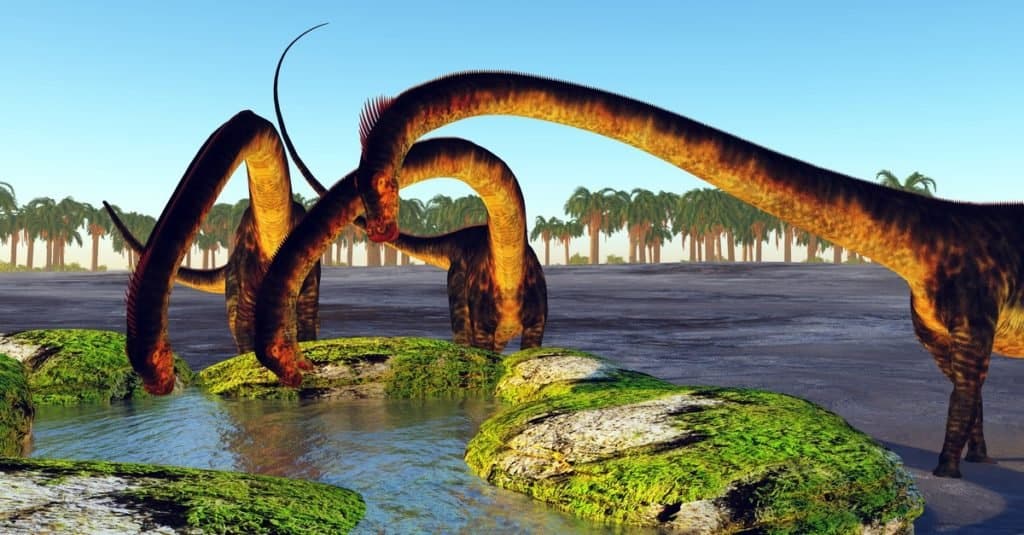Barosaurus
Barosaurus lentus
If a barosaurus were alive today, it could stand on its hind legs and look in a 5th floor apartment window.
Advertisement
Barosaurus Scientific Classification
- Kingdom
- Animalia
- Phylum
- Chordata
- Class
- Reptilia
- Order
- Saurischia
- Family
- Diplodocidae
- Genus
- Barosaurus
- Scientific Name
- Barosaurus lentus
Read our Complete Guide to Classification of Animals.
Barosaurus Conservation Status
Barosaurus Facts
- Prey
- Herbivorous
- Main Prey
- Herbivorous
- Name Of Young
- Hatchling or nestling
- Group Behavior
- Herd
- Fun Fact
- If a barosaurus were alive today, it could stand on its hind legs and look in a 5th floor apartment window.
- Biggest Threat
- Climate change
- Most Distinctive Feature
- The longest neck of any sauropod.
- Distinctive Feature
- A long whip-like tail.
- Other Name(s)
- Barosaurus lentus
- Temperament
- Placid
- Habitat
- Warm, semi-arid coniferous forest.
- Predators
- Allosaurus
- Diet
- Herbivore
- Lifestyle
- Herd
- terrestrial
- Favorite Food
- Conifers, ferns
- Location
- South Dakota and Utah, US
View all of the Barosaurus images!
Barosaurus (pronunciation BAH-roe-SORE-us) was one of the largest animals ever to walk the earth. Some scientists think it may have had as many as 8 hearts. Like other sauropods, it had a long neck and tail and walked on four legs as big as tree trunks. Its femur was almost 5 feet long! It could stand up on its back legs to defend itself or to eat from the tops of trees. It went extinct in the Jurassic period, but if it were alive today, at its height it could look into a 5th story window. We can only guess at the dinosaur face you’d see through that window though, because no Barosaurus skulls have ever been discovered, only partial skeletons.
Description & Size
The name Barosaurus comes from a couple of Greek words that mean “heavy lizard.” And it was certainly heavy! It weighed up to 20 tons, as much as 3 male African elephants! It was 79-85 feet from the tip of its nose to the tip of its tail and its height could be 40-45 feet. Its four legs each had massive femurs nearly 5 feet long. It would have moved slowly, but if it were in danger it might be able to muster up a gait of 10 mph.
Barosaurus had a long tail, but shorter than its cousin Diplodocus. On the other end, it had the longest neck of any of the sauropod dinosaur family. Despite its length, a Barosaurus neck had only 15-16 vertebrae (compare that to 7 in the human neck). However, some of those vertebrae were 39 inches long! It could also stand up on its back legs to reach high branches or defend itself, raising its head to the dizzying height of 5 stories above ground level.
One of the mysteries of the Barosaurus is how its heart could pump blood all the way to its brain at such a height. An animal this size would have to have a heart weighing over 1.5 tons to keep its blood pressure high enough to get oxygen to the brain and keep from fainting. Two other theories are that it may have had as many as 8 hearts positioned in its chest and along its neck to keep the blood flowing, or it may have had a system of valves in its neck, similar to a giraffe.
We don’t know what color Barosaurus was, but we do know what the texture of its skin was like. An 8-inch piece of fossilized skin was discovered clinging to a limb bone. The surface is very bumpy, resembling somewhat an alligator‘s skin.
No Barosaurus skulls have been discovered, but researchers assume it would have looked similar to other sauropods such as Diplodocus, with a small head and blunt peg-like teeth used for chewing tough fibers of tree branches. The small heads of this family of dinosaurs meant they also had small brains.

This 3D illustration shows just how long the Barosaurus’ neck was.
©Catmando/Shutterstock.com
Diet – What Did Barosaurus Eat?
The Barosarus was strictly a plant eater. Its physical structure would have allowed it to eat from the very tops of trees that smaller herbivores could not reach. However, based on the shape of its vertebrae, Barosaurus may have most often fed by standing in one place and sweeping its neck in long arcs to reach every green thing from ground level to treetops.
During the late Jurassic period, when it lived, gymnosperms–cone-bearing plants–became widespread. This means Barosaurus may have eaten conifers (such as pine trees) or ginkgo’s. Edible ferns and some flowering plants would have been on the forest floor. The Barosaurus would have to eat many thousands of pounds of forage every day to maintain its massive weight.
Habitat — When and Where It Lived
The Barosaurus lived during the late Jurassic period, about 155-145 million years ago. This was the height of the sauropods, when they reached their greatest size, biological diversity, and geographic distribution.
At this time the Pangea supercontinent had already started to split up but the continents were still close to each other, separated by warm shallow seas. Because there was so much plate tectonic activity going on, there was a lot of mountain building and volcanic activity. The world of the Barosaurus may have been frequently shaken by earthquakes, with skies darkened from time to time by clouds of volcanic ash.
Most fossils of the Barosaurus have been discovered in the United States in South Dakota and Utah. Earlier, this area had been covered by a shallow sea, but by the late Jurassic period the sea had retreated. The temperature was tropical. There were no glaciers or polar ice caps. Plants adapted to warm climates grew almost as far north as modern Iceland and as far south as the tip of South America. Scientists speculate that volcanic activity may have released a large amount of greenhouse gases that warmed the earth at that time. Temperatures in the area where Barosaurus lived may have ranged from 68 degrees in winter to 113 in summer in a semi-arid climate.
Some of the other herbivorous dinosaurs Barosaurus may have shared habitat with were the Camptosaurus, Dryosaurus, Othnielosaurus, and Stegosaurus. Pterosaurs (flying reptiles) and some early birds glided in the sky. Lizards, frogs, turtles, and early mammals such as docodontas, multituberculates, and triconodonts hid in the underbrush. There were a wide variety of insects at this time as well, including dragonflies. Plesiosaurs, with their long necks and flippers, along with ancestors of squids, sharks, and rays, were swimming the seas.
Threats and Predators
The main predators during this time period were theropods, including Ceratosaurus, Marshosaurus, Ornitholestes, Saurophaganax, Stokesosaurus, and Torvosaurus. However, the predator at the top of the food chain was the Allosaurus, a theropod dinosaur that walked on its back legs, had short arms and attacked with jaws full of dagger-sharp teeth. At 28 feet long, and nearly 2 tons in weight, it was the largest carnivore at the time, but was far smaller than the Barosaurus.
Even though Barosaurus didn’t have a big brain or sharp teeth and claws, it had formidable defenses. It could raise up on its back legs to terrifying heights and use its powerful legs and massive feet to crush an enemy. It could also swing its tail hard enough to shatter its enemy’s bones. Like other herbivores, the Barosaurus may also have moved around with others in herds, multiplying its defensive power.
Because of this, an Allosaurus probably would avoid taking on a healthy adult Barosaurus, but would have kept its senses alert to opportunities to pick off a baby or an injured, sick, or elderly one. When a large Barosaurus died, the body may have been surrounded by large numbers of predators for days until it was all consumed.
Discoveries and Fossils – Where It Was Found
The first incomplete Barasaurus skeleton was discovered in South Dakota by Ms. E. R. Ellerman and excavated in 1889 by Othniel Marsh and John Hatcher. In 1929 Earl Douglass uncovered a more complete skeleton at the Carnegie Quarry, located at Dinosaur National Monument, Utah.
You can see the most complete Barosaurus skeletons at the Royal Ontario Museum, Toronto, Canada or at the American Museum of Natural History, New York City, United States.
Extinction – When did it die out?
The last Barosaurus likely died after the Tithonian age at the very end of the Jurassic period. Paleontologists do not know for certain what caused their extinction but theorize that it may have been due to evolutionary changes or climate changes that disrupted their niche in the ecosystem.
Similar Animals to the Barosaurus
As a part of the sauropod family of dinosaurs, the Barosaurus was related to the Apatosaurus, Brachiosaurus, and Diplodocus. Compared to its other sauropod cousins, Barosaurus had a longer neck and shorter tail. It also had longer and thinner forelimbs than Diplodocus, with 5 ft. long femurs.
Related Animals
View all 285 animals that start with BBarosaurus FAQs (Frequently Asked Questions)
Is Barosaurus the biggest dinosaur?
It is one of the largest, but not the largest. That honor goes to Argentinosaurus, which was 121-131 feet long and weighed 99-110 tons. This makes it the largest dinosaur and largest land animal ever known.
How many hearts did a Barosaurus have?
Palentologists are not sure. Some think it had one big heart weighing 1.5 tons; others think it may have had as many as 8 hearts positioned in the chest and along the neck to pump blood to the brain. Soft-tissue internal organs such as the heart do not survive as fossils so it is impossible to know for sure.
When did the Barosaurus go extinct?
The last Barosaurus likely died after the Tithonian age at the very end of the Jurassic period. Paleontologists do not know for certain what caused their extinction but theorize that it may have been due to evolutionary changes or climate changes that disrupted their niche in the ecosystem.
When was the Barosaurus Alive?
The late Jurassic period, about 155-145 million years ago.
How Big was Barosaurus?
It weighed up to 20 tons and was 79-85 feet long and 40-45 feet in height.
Thank you for reading! Have some feedback for us? Contact the AZ Animals editorial team.
Sources
- EOL Encyclopedia of Life, Available here: https://eol.org/pages/47459351
- Carnivora, Available here: https://carnivora.net/barosaurus-lentus-t1311.html
- National Park Service, Available here: https://www.nps.gov/dino/learn/nature/barosaurus-lentus.htm
- ROM: Royal Ontario Museum, Available here: https://collections.rom.on.ca/objects/3470/sauropod-dinosaur?ctx=02482010-c72e-4db3-8dd7-c6417b09ea81&idx=0
- DinoPit: Dinosaurs Online, Available here: https://www.dinopit.com/barosaurus/
- Natural History Museum, London, Available here: https://www.nhm.ac.uk/discover/dino-directory/barosaurus.html
- The Washington Post, Available here: https://www.washingtonpost.com/archive/politics/1992/08/31/paleontology-barosaurus-may-have-had-8-hearts/4018ad5e-e10b-4836-839a-251234f6adca/
- Britannica, Available here: https://www.britannica.com/science/Jurassic-Period
- LiveScience, Available here: https://www.livescience.com/28739-jurassic-period.html#:~:text=Plant%20life&text=During%20the%20Jurassic%2C%20a%20new,Jurassic%2C%20the%20gymnosperms%20were%20widespread.
















